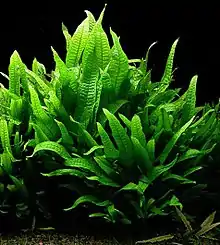Leptochilus pteropus
Leptochilus pteropus, synonym Microsorum pteropus,[1] commonly known as Java fern after the Indonesian island of Java, can be found in Malaysia, Thailand, Northeast India and some regions of China. It is a highly variable plant with several different geographic varieties that vary in leaf size and shape. Found in its natural habitat growing attached to roots and rocks, it can grow in both fully and partially submerged environments. The plant can propagate through small adventitious plants formed on older leaves, which attach themselves to hard substrates.
| Leptochilus pteropus | |
|---|---|
 | |
| Scientific classification | |
| Kingdom: | Plantae |
| Clade: | Tracheophytes |
| Division: | Polypodiophyta |
| Class: | Polypodiopsida |
| Order: | Polypodiales |
| Suborder: | Polypodiineae |
| Family: | Polypodiaceae |
| Genus: | Leptochilus |
| Species: | L. pteropus |
| Binomial name | |
| Leptochilus pteropus | |
_growing_in_the_wild..jpg.webp)
Cultivation and uses
Java fern is one of the most popular plants in the aquarium hobby, due to its aesthetic appeal and ease of care. Several cultivars of Java fern exist, including the "narrow leaf", "needle leaf", "Windelov", "trident", and "lance leaf" variants. Cultivation in the aquarium is usually performed by tying or glueing the roots coming from the rhizome to rock or driftwood, instead of planting it directly into the substrate.[2]
It can be cultivated in tap water, dim or bright light, with or without gravel. It is more snail resistant and grows better with higher fish loads.[3]
References
- Hassler, Michael & Schmitt, Bernd (January 2020). "Leptochilus pteropus". Checklist of Ferns and Lycophytes of the World. Version 8.20. Retrieved 2020-02-11.
- "How to Plant Anubias or Java Fern on Rocks and Driftwood". Aquarium Co-Op. Retrieved 2022-04-30.
- "Java Fern Care, Reproduction and Fact sheet | The Aquarium Club". theaquarium.club. Retrieved 2018-02-08.